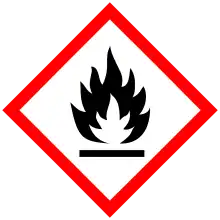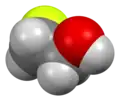| |||
| Names | |||
|---|---|---|---|
| Preferred IUPAC name
2-Fluoroethan-1-ol | |||
| Other names
Ethylene fluorohydrine | |||
| Identifiers | |||
3D model (JSmol) |
|||
| ChEMBL | |||
| ChemSpider | |||
| ECHA InfoCard | 100.006.128 | ||
PubChem CID |
|||
| UNII | |||
CompTox Dashboard (EPA) |
|||
| |||
| |||
| Properties | |||
| C2H5FO | |||
| Molar mass | 64.059 g·mol−1 | ||
| Density | 1.1040 g cm−3[1] | ||
| Melting point | −26.3 °C (−15.3 °F; 246.8 K)[1] | ||
| Boiling point | 103.5 °C (218.3 °F; 376.6 K)[1] | ||
| miscible[1] | |||
| Solubility | Soluble in ethanol, ethyl ether, acetone | ||
| Vapor pressure | 19 mbar (15 °C)[1] | ||
| Acidity (pKa) | 14.74 (predicted)[2] | ||
| Hazards | |||
| GHS labelling: | |||
  | |||
| H226, H300+H310+H330 | |||
| P210, P233, P240, P241, P242, P243, P260, P262, P264, P270, P271, P280, P284, P301+P310+P330, P303+P361+P353, P304+P340+P310, P363, P370+P378, P403+P233, P403+P235, P405, P501 | |||
| NFPA 704 (fire diamond) | |||
| Flash point | 34 °C (93.2 °F; 307.15 K) | ||
| Related compounds | |||
Other anions |
2-Chloroethanol | ||
Except where otherwise noted, data are given for materials in their standard state (at 25 °C [77 °F], 100 kPa).
Infobox references | |||
2-Fluoroethanol is the organic compound with the formula CH2FCH2OH. This colorless liquid is one of the simplest stable fluorinated alcohols. It was once used as a pesticide. The related difluoro- and trifluoroethanols are far less dangerous.[3]
Synthesis
2-Fluoroethanol was originally synthesized by treating 2-chloroethanol with potassium fluoride, in a simple Finkelstein reaction.[4] The product has a lower boiling point that the starting material and may be conveniently isolated by distillation.
- ClCH2CH2OH + KF → FCH2CH2OH + KCl
Similar procedures start from (1,3)-dioxolan-2-one[5] and from 2-bromoethanol.[6]
Structure and reactivity
Hydrogen bonding stabilizes the gauche conformer.[7][8]
In a basic solution, 2-fluoroethanol undergoes dehydrofluorination, giving acetaldehyde.[9]
Reaction of 2-fluoroethanol with trifluoromethanesulfonic anhydride in the presence of base gives the triflate ester.[10]
PET radiotracers
2-[18F]-fluoroethoxy group is a common moiety in the structures of radiotracers used with PET. Such radiotracers include fluoroethyl-l-tyrosine 1-(2-[18F]-fluoroethoxy)-4-nitrobenzene and [18F]-fluoroethyl 4-fluorobenzoate, being a [18F]fluoroalkyl ether and ester respectively.[11][10]
Metabolism
It was patented as a rodenticide in Germany in 1935.[12] In rats, it was found that fluoroethanol induced a similar toxicity as that of fluoroacetate, known to metabolize to fluorocitrate to exert the toxic effect.[12]
2-Fluoroethanol is converted by alcohol dehydrogenase (ADH) using nicotinamide adenine dinucleotide (NAD+) as cofactor,[12] ultimately leading to the formation of fluoroacetaldehyde and then fluoroacetate.[12]
Fluoroacetate is a precursor to fluorocitrate,[13] an inhibitor of aconitase, an enzyme that participates in the TCA cycle.[14]
Toxicity
Reported effects of 2-fluoroethanol are epigastric distress effects, such as vomiting, and central nervous effects, such as auditory hallucinations, numbness feeling of the face or nose. Both these types of effects occur gradually after being exposed to 2-fluoroethanol for several hours. Some more severe reactions of the human body to 2-fluoroethanol can be respiratory failure and epileptiform convulsions or seizures, leading to dysfunctions in the heart mechanism. From the early 20th century, there are multiple reports of deaths caused by 2-fluoroethanol.[15]
2-Fluoroethanol is also toxic to other animals with LD50 ranging from 7 to 1500 mg/kg bodyweight.
See also
References
- 1 2 3 4 5 6 Record of CAS RN 371-62-0 in the GESTIS Substance Database of the Institute for Occupational Safety and Health, accessed on 18. February 2010.
- ↑ "Ethylene fluorohydrin (CHEM004230)".
- ↑ Siegemund, Günter; Schwertfeger, Werner; Feiring, Andrew; Smart, Bruce; Behr, Fred; Vogel, Herward; McKusick, Blaine (2000). "Fluorine Compounds, Organic". Ullmann's Encyclopedia of Industrial Chemistry. Weinheim: Wiley-VCH. doi:10.1002/14356007.a11_349. ISBN 978-3527306732.
- ↑ Hoffmann, Friedrich W. (1948). "Preparation of Aliphatic Fluorides". Journal of the American Chemical Society. 70 (7): 2596–2597. doi:10.1021/ja01187a505. PMID 18875124.
- ↑ Shahak, Israel; Bergmann, Ernst D. (1965). "A convenient of synthesis β- and γ-fluoro-alcohols". Chem. Commun. (7): 122a. doi:10.1039/c1965000122a.
- ↑ Bhadury, Pinaki S.; Raza, Syed K.; Jaiswal, Devendra K. (1999). "A semi-molten mixture of hexadecyltributylphosphonium bromide and potassium fluoride in the synthesis of organofluorine compounds". Journal of Fluorine Chemistry. 99 (2): 115–117. doi:10.1016/s0022-1139(99)00121-9.
- ↑ Huang, Jinfan; Hedberg, Kenneth (1989). "Conformational analysis. 13. 2-Fluoroethanol. An investigation of the molecular structure and conformational composition at 20, 156, and 240.degree.. Estimate of the anti-gauche energy difference". Journal of the American Chemical Society. 111 (18): 6909–6913. doi:10.1021/ja00200a003.
- ↑ Dixon, David A.; Smart, Bruce E. (1991). "Conformational energies of 2-fluoroethanol and 2-fluoroacetaldehyde enol: Strength of the internal hydrogen bond". The Journal of Physical Chemistry. 95 (4): 1609–1612. doi:10.1021/j100157a020.
- ↑ Bronnert, D.L.E.; Saunders, B.C. (1960). "Toxic fluorine compounds containing the C—F link—XI". Tetrahedron. 10 (3–4): 160–163. doi:10.1016/s0040-4020(01)97802-0.
- 1 2 Falzon, C. L., Ackermann, U., Spratt, N., Tochon-Danguy, H. J., White, J., Howells, D., & Scott, A. M. (2006).F-18 labelledN,N-bis-haloethylamino-phenylsulfoxides — a new class of compounds for the imaging of hypoxic tissue. Journal of Labelled Compounds and Radiopharmaceuticals, 49(12), 1089–1103. https://doi.org/10.1002/jlcr.1129
- ↑ Pan, J., Pourghiasian, M., Hundal, N., Lau, J., Bénard, F., Dedhar, S., & Lin, K.-S. (2013). 2-[18F]-fluoroethanol and 3-[18F]-fluoropropanol: facile preparation, biodistribution in mice, and their application as nucleophiles in the synthesis of [18F]fluoroalkyl aryl ester and ether PET tracers. Nuclear Medicine and Biology, 40(6), 850–857. https://doi.org/10.1016/j.nucmedbio.2013.04.009
- 1 2 3 4 Treble D. H. (1962). The metabolism of 2-fluoroethanol. The Biochemical journal, 82(1), 129–134. https://doi.org/10.1042/bj0820129
- ↑ Goncharov, N. V., Jenkins, R. O., & Radilov, A. S. (2006). Toxicology of fluoroacetate: a review, with possible directions for therapy research. Journal of applied toxicology : JAT, 26(2), 148–161. https://doi.org/10.1002/jat.1118
- ↑ Timbrell, J. A. (2008). Principles of Biochemical Toxicology (Fourth Edition). Taylor & Francis. p. 358-359.
- ↑ Saunders, B. C., Stacey, G. J., & Wilding, I. G. E. (1948). Toxic Fluorine Compounds Containing the C-F Link. Part II. 2-Fluoroethanol and its Derivatives. University Chemical Laboratory Cambridge, 1. Retrieved from https://pubs-rsc-org.ru.idm.oclc.org/en/content/articlepdf/1949/jr/jr9490000773.


